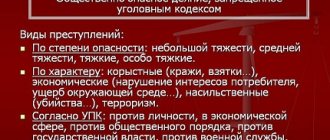Concept, meaning of the subjective side of the crime
1. Subjective side
- this is an element of the crime that determines the internal side of the committed socially dangerous act. It is inextricably linked with the objective side, therefore the essence of the subjective side is the mental attitude of the criminal to the socially dangerous act he committed. Its content is predetermined by the characteristics of the intellectual, volitional and emotional spheres of activity of the person who committed the crime. The nature of guilt, its differentiation into forms and types depends on the specific relationship of the intellect and will to the committed act and the ensuing consequences. The emotional sphere determines the motivational coloring of the action and its goals.
2. Thus, the characteristics that form the subjective side of the crime include guilt, motive and purpose.
Guilt is an obligatory sign of the subjective side, its core. This provision is of a fundamental nature and is enshrined in Art. 5 of the Criminal Code of the Russian Federation as a principle of criminal law. In all compositions, without exception, constructed in the Special Part of the Criminal Code, the wine and its form are indicated. The absence of guilt at all or its corresponding form indicates the absence of a crime.
The subjective side of the crime is described in the criminal law norm of the Special Part in less detail compared to the objective side. Therefore, when analyzing it, it is necessary to refer to the norms of the General Part (Articles 24-28 of the Criminal Code of the Russian Federation).
Optional characteristics
the subjective side is
the motive
and
goal.
In principle, any human behavior depends not only on the consciousness and will of the person, but also on his motives and goals. But for bringing to criminal liability and determining its limits, not any motives and goals are important, but only those named in the relevant norms. Moreover, like other optional features, motive and purpose play a triple role (a mandatory feature, a qualifying feature, as well as a mitigating or aggravating circumstance). Therefore, the most important condition for the correct application of criminal law is the precise establishment of the nature and characteristics of the subjective side of the crime described in the law (guilt, motive and purpose).
3. Subjective side
crime is important in criminal law:
a) it determines the subjective boundaries of criminal liability, excluding the possibility of objective imputation; b) as an element of the crime it is included in the basis of criminal liability; c) the subjective side ensures the correct qualification of crimes and contributes to the differentiation of similar offenses; d) the content of guilt, the nature of the motive and purpose are taken into account when assigning punishment.
Not everything is so clear
As judicial practice shows, in some cases the main character of the situation really does not care about the consequences of his behavior, but this is not observed in one hundred percent of cases. Moreover, lawyers and psychologists agree that it is extremely difficult for a normal person to remain indifferent, understanding the possible consequences of activity, including those associated with crimes. The reason is the possibility of criminal liability, because if the agreed consequences occur, you will have to appear in court. In most cases, a person who finds himself in a corresponding situation wants to prevent criminal consequences from occurring. However, this does not prevent many people from doing things that could potentially lead to such a result.
Wine, its forms
Guilt
(Articles 5, 24, 25, 26 of the Criminal Code) is a mandatory sign of the subjective side of the crime, understood as
the mental attitude of a person to the act committed and the consequences that have occurred.
The doctrine of guilt is core in the theory of criminal law and in judicial practice.
As Prof. wrote. N.S. Tagantsev, every civilized state is extremely concerned “... so that falsehood does not outweigh the truth, and so that during this triumph of truth, the punishing sword of justice strikes only the guilty and strikes according to his guilt
.
Scientists have repeatedly addressed problems associated with understanding guilt, the content of its forms and types. Two main concepts of guilt have emerged: a) the psychological content of guilt; b) “evaluative” understanding of guilt. According to the first concept, guilt is a mental attitude towards what has been done, it is a specific activity of the intellect and will, a conscious-volitional process.
Proponents of the second concept do not recognize guilt as objective certainty. Guilt, in their opinion, is only the subjective confidence of the court in the guilt of the accused, based on the external consistency of the impressions received by the court. The “reproachability” of a person’s behavior is the basis of criminal liability.
Russian criminal law adheres to the concept of the psychological content of guilt. Guilt is characterized by intellectual and volitional moments. Awareness of the social danger of an act, anticipation of socially dangerous consequences
- intellectual moments.
Desire, conscious assumption
or
indifference to the onset of socially dangerous consequences,
as well as
arrogant calculation to prevent them
are volitional moments of guilt.
2. The Criminal Code of the Russian Federation in 1996 introduced for the first time a rule containing the concept of forms of guilt. Part 1 art. 24 “Forms of Guilt” states: “A person who committed an act intentionally or through negligence is found guilty of a crime.” In Art. 25 and 26 of the Criminal Code, these forms of guilt receive a detailed description. Depending on the combination of intellectual and volitional aspects, a legislative definition of the forms of guilt is formulated: intent and negligence.
The criminal legal meaning of guilt, its division into forms is of great theoretical and practical importance. In cases where the legislator differentiates responsibility depending on the form of guilt, it affects the qualification of crimes. Depending on the forms of guilt, the legislator distinguishes categories of crimes, types of plurality, and relapse. The institution of complicity (deliberate joint participation in a deliberate crime) is also associated with the intentional form of guilt.
3. The legislator, when constructing specific elements in the Special Part of the Criminal Code, in some cases directly indicates an intentional form of guilt (Article 167 of the Criminal Code - intentional destruction or damage to property) or a careless form (Article 168 of the Criminal Code - destruction or damage of property through negligence). However, often the form of guilt is not specified in the criminal law. Previously, when qualifying, law enforcement officers experienced difficulties in deciding the question of what form of guilt these crimes could be committed with. Both intentional and careless forms were allowed. The 1996 Criminal Code of the Russian Federation eliminated this discrepancy by introducing Part 2 of Art. 24, which establishes: “An act committed only through negligence is recognized as a crime only in the case when it is specifically provided for by the relevant article of the Special Part of this Code” (as amended by the Federal Law of June 25, 1998). Consequently, in cases where the disposition of the article of the Special Part does not indicate the form of guilt, the crime provided for by this norm can only be intentional.
In addition, by introducing this rule, the legislator significantly narrowed the scope of application of a careless form of guilt.
Not everything is monotonous
Examples of indirect intent from judicial practice also contain references to such events when the consequences were provoked by the absence of any actions. Moreover, the main character, without any reason, hoped that negative results simply would not occur. On the one hand, the will seems to be aimed at preventing a negative outcome, but hopes and calculations are so abstract that they have no logical explanation or basis. A good term to describe this situation is “at random.”
When analyzing what happened, the court pays special attention to assessing how much the subject of the situation realized that the consequences of the crime could be negative. In conclusion, the judge formulates to what extent the active character intended to prevent the onset of a negative result, and based on such conclusions makes a final decision on the situation.
Intention, its types
1. Intent
(Article 25 of the Criminal Code of the Russian Federation) - this is the most common form of guilt - in 227 articles of the Special Part of the Criminal Code out of 256, the legislator provided for it. Intentional crimes pose the greatest danger to society, which naturally arouses particular interest among scientists and practitioners. For the first time, intent as an independent form of guilt received a clear theoretical justification in C. Beccaria’s treatise “On Crimes and Punishments,” published back in 1764. It should be noted that Russian criminal law traditionally adheres to the main provisions of this treatise. Part 1 art. 25 of the Criminal Code of the Russian Federation establishes: “A crime committed intentionally is recognized as an act committed with direct or indirect intent,” i.e. distinguishes two types of intent.
2. Direct intent
occurs when a person was aware of the social danger of his act, foresaw the possibility or inevitability of the occurrence of socially dangerous consequences and desired their occurrence (Part 2 of Article 25 of the Criminal Code).
The consciousness
of a person must cover all the factual circumstances of the case, provided for by the disposition of the relevant norm of the Special Part of the Criminal Code, and their social significance.
Thus, when committing theft of someone else's property with entry into a home, the culprit is aware that he is unlawfully taking someone else's property without compensation in a secret way with illegal entry into the home. A person’s awareness of all these circumstances also determines the awareness of the social danger of behavior.
The second intellectual moment of direct intent is foresight,
those.
a person’s mental representation of the direction of development of cause-and-effect relationships between his act and the socially dangerous consequences that have occurred, and the anticipation of the possibility
or
inevitability
of their occurrence.
Thus, a killer, cutting off the head of a victim or using a powerful explosive device, foresees the inevitability of death. At the same time, when shooting at a victim from a considerable distance, a person foresees only the possibility of death, which depends on various circumstances (ballistic, skill of the shooter, etc.). However, the consequences are foreseen as realistically possible,
and not
abstract.
Volitional moment
direct intent is
the desire for
socially dangerous consequences to occur when the will of a person is mobilized to achieve specific consequences. The perpetrator acts purposefully. Therefore, if a specific goal is indicated in a criminal law norm, then intent can only be direct. But this does not mean that the desired consequences and the goal are always the same. Three situations can be distinguished.
The first, most often encountered in judicial practice, is when the criminal consequences coincide with the goal of the perpetrator. Thus, a person, out of revenge for an insult, kills the offender. The goal of dealing with the enemy coincided with the desire to cause his death.
In the second situation, the desired consequences act as an intermediate stage in the commission of another crime. So, K. and P., with the intention of creating a gang, kill a police officer in order to seize his weapon.
And the third situation is when the desired criminal consequences are a means of achieving a certain goal. Thus, the culprit, pursuing the goal of quickly obtaining an inheritance,
gives a lethal dose of poison to his elderly father, who dies. In this case, the death of the parent was a necessary condition for receiving the inheritance.
The legislative formula of direct intent (knows the act - foresees the consequences - desires the consequences) is provided for crimes with a material element, in which criminal consequences are a mandatory feature. And the volitional moment of intent extends to them.
The formula of direct intent in crimes with a formal composition looks somewhat different, when the legislator considered it necessary to extend the criminal consequences beyond the scope of the composition. In these cases, intellectual and volitional aspects are transferred to action.
For example, insult, i.e. humiliation of the honor and dignity of another person, expressed in indecent form (Part 1 of Article 130 of the Criminal Code). In this composition, the limits of desire are limited to the commission of an act - to humiliate another person in an indecent form.
The norms of the Special Part of the Criminal Code of the Russian Federation do not indicate the possible type of intent. However, there are certain features of constructing the composition that predetermine the possibility of only direct intent: a) in all crimes with a formal composition; b) if the disposition specifies the purpose of committing the crime.
3. In part 3 of Art. 25 of the Criminal Code of the Russian Federation determines the content of intellectual and volitional moments of indirect intent. A crime is considered committed with indirect intent if the person was aware
the social danger of his actions (inaction), foresaw
the possibility
of socially dangerous consequences, did not want, but
consciously allowed
indifferent
to them .
The first intellectual moment - awareness of the act - is formulated in the same way as in direct intent, their content is adequate.
The second intellectual point - the anticipation of consequences - is defined differently. With indirect intent, a person foresees only the possibility of consequences. Foreseeing the inevitability of their occurrence is characteristic exclusively of the direct. This is the first difference between indirect intent and direct intent.
The main difference is made in the characteristics of the volitional moment. The law emphasizes that the person does not want the consequences to occur. The perpetrator does not need these consequences either as an ultimate or as an intermediate goal. The purpose of the person is outside the scope of the crime, and socially dangerous consequences are a by-product of criminal actions. And the culprit agrees with their onset, either consciously allowing them or being indifferent. So, a person, being in a state of drug intoxication, opens random fire in the room and kills one of those present.
When assessing the elements of a crime legally, it is necessary to keep in mind that indirect intent is possible only in material elements.
The division of the intentional form of guilt into direct and indirect intent is of great practical importance in the classification of crimes. Thus, during preparation and attempt, only direct intent must be established; Organizers and instigators act with direct intent. The correct determination of the type of intent contributes to the individualization of punishment for the perpetrators.
4. In addition to the legislative division of intent into direct and indirect, in the theory of criminal law and judicial practice, other types of intentional forms of guilt are distinguished. Thus, according to the time criterion, intent is distinguished as “suddenly arising” and “premeditated”. The first type of intent is characterized by the fact that it arises at the scene of the crime and is realized instantly or after a short period of time. Sudden intent is often formed as a result of certain victimized (provoking) behavior of the victims. In such cases, it represents a lesser degree of public danger than a premeditated one.
With premeditated intent, the criminal intent is realized within a certain time after its occurrence. During this period, the person considers a plan to commit a crime, eliminate obstacles, sometimes there is a “struggle of motives” (thirst for profit and fear of punishment, pity for the victim, etc.). This type of intent, as a rule, indicates a higher degree of social danger of the crime and the person who committed it.
The next criterion for dividing intent is the certainty of presentation
the perpetrator about the socially dangerous consequences of his act. Definite and indefinite intent are distinguished.
Certain intent
occurs when the perpetrator clearly understands the nature of the consequences of his act and their size.
This type of intent can be simple,
when the subject foresees one specific consequence, for example, the death of the victim in a murder, or
alternative,
when the perpetrator foresees the occurrence of two or more consequences (but specific). Thus, the perpetrator, when stabbing the chest with a knife, foresees the possibility of causing death or serious harm to health and desires or consciously allows the occurrence of any of them. With this type of intent, the qualification of the actions of the perpetrator is carried out in accordance with the consequences that occurred (Article 105 or Article 111 of the Criminal Code of the Russian Federation).
Uncertain intent
characterized by the fact that the perpetrator, foreseeing the onset of criminal consequences, does not specify them. He only has a general idea of the harm he will cause through his actions. Most often, this type of intent occurs when causing bodily harm in fights, when the limits of necessary defense are exceeded, or in a state of passion. Such acts are classified depending on the actual consequences.
Continuing consideration
A similar situation of indirect intent is observed when analyzing the incident described below. A certain citizen, under the influence of alcoholic beverages, took out a weapon while in a room filled with people and began shooting randomly. This behavior caused one death and three injuries. Of course, the man who found himself at the center of events understood perfectly well that he was carrying out actions that were dangerous to the public. Moreover, he foresaw that criminal consequences in such a situation would most likely occur, but he accepted this knowledge indifferently. The main character of the situation consciously allowed any possible consequences of his behavior, including death in relation to those around him.
Negligence, its types
1. The current Criminal Code contains only 29 articles in which elements with a careless form of guilt are constructed. Another 28 articles provide for qualifying circumstances associated with careless infliction of harm. But this does not mean that the degree of danger of this group of crimes is low and should not be underestimated. The absolute number of them is growing, especially crimes related to violation of the rules of environmental protection, labor protection, traffic safety and operation of all types of transport. Therefore, the problem of criminal liability for careless crimes, as well as the theoretical development of the concept of negligence and its types, become important.
2. Carelessness
- this is a special form of guilt, consisting in a mental attitude to criminal consequences (awareness of the social danger of the act is taken beyond the concept of negligence). Therefore, negligence can only occur in crimes with a material element. The law establishes two types of negligence: frivolity and negligence (Article 26 of the Criminal Code).
frivolity
— “a crime is recognized as committed due to frivolity if a person foresaw the possibility of socially dangerous consequences of his actions (inaction), but without sufficient grounds for this he arrogantly counted on preventing these consequences (Part 2 of Article 26 of the Criminal Code).
The intellectual moment of levity lies in anticipating
the possibility of consequences. Thus, a truck driver, speeding on a village street, foresees that a child may run out of the gate of the house, a cyclist may emerge from the alley, and he may cause death or harm to the health of this unidentified person. The legislator did not introduce the mental attitude to the act itself into the concept of guilt, since it (without consequences) has no criminal legal significance. This is either an administrative offense, or a disciplinary offense, or does not fall within the scope of regulation of any branch of law.
The volitional moment of frivolity lies in the unfounded (overconfident) calculation of preventing foreseeable consequences. It should be borne in mind that the person was counting on some circumstances that, in the opinion of the perpetrator, could prevent the occurrence of socially dangerous consequences. Such real circumstances can be the personal qualities of the subject himself (professional skill, strength, dexterity, speed of reaction), properties of mechanisms, forces of nature.
But the calculation did not come true in a specific situation. For example, a truck driver who was speeding hesitated when a teenager rode out of an alley on a bicycle and did not have time to brake. As a result of the collision, serious harm was caused to the health of the victim (Part 1 of Article 264 of the Criminal Code).
3. The legislative formulation of the intellectual moment of frivolity is similar to the intellectual moment of indirect intent. Therefore, there is always a need to differentiate between these types of guilt. The first distinctive feature is the content of the foresight.
With indirect intent, the perpetrator foresees
the real
possibility of socially dangerous consequences. This conclusion is predetermined by the content of the first intellectual moment - the awareness of a socially dangerous act. The person foresees that committing this act (for example, shooting a victim) will lead to a specific consequence, i.e. the death of this particular victim.
In case of frivolity, the perpetrator foresees only the abstract possibility of a socially dangerous consequence. In the example above, the truck driver anticipates that in a similar situation, if he speeds too much, a collision with a cyclist or pedestrian may occur, but he excludes this possibility for himself.
The second distinctive feature lies in the content of the volitional moment.
With indirect intent, the subject, not wanting socially dangerous consequences to occur, nevertheless accepts them, he
consciously
allows them or is indifferent.
In case of frivolity, the perpetrator does not want to, does not consciously allow, does not treat indifferently. On the contrary, his consciousness and will are active, he makes volitional efforts to prevent them. At the same time, he relies on real circumstances. But the decision turns out to be arrogant, the efforts are insufficient, and criminal consequences occur.
Establishing the noted differences is necessary in every criminal case related to causing death, grievous and moderate harm to health, since the danger of intentionally causing the noted consequences is immeasurably higher than in case of careless guilt (murder with indirect intent - part 1 of article 105 of the Criminal Code - from six to fifteen years of imprisonment; causing death through frivolity - Part 1 of Article 109 of the Criminal Code - imprisonment for up to three years).
4. Negligence
- This is the second type of careless form of guilt.
Part 3 Art. 26 of the Criminal Code defines it as follows: “A crime is recognized as committed through negligence if a person did not foresee the possibility of socially dangerous consequences of his actions (inaction), although with the necessary care and forethought he should and could have foreseen these consequences.” The intellectual aspect
of negligence distinguishes it from other types of guilt.
The perpetrator is not aware of
the social danger of the act committed and does not
foresee
the possibility of criminal consequences.
If a person does not realize the nature of his actions and does not foresee the possibility of a criminal result, then should he bear criminal liability? This issue has long been of interest to the theory of criminal law and judicial practice. Two theories have been put forward. The first is the “average man theory,” which originated in Roman law. The average person is like the “objective scale” that the judge uses. And if he comes to the conclusion that the defendant fits this scale, he will issue a guilty verdict. The characteristics and properties of a particular person were not taken into account. This approach to understanding negligence created the basis for subjectivity, everything depended on the opinion of the judge.
Meanwhile, the development of science and technology, the increase in the number and speed of vehicles and other sources of increased danger have led to a sharp increase in the number of crimes of this kind. A different scientifically based solution to the problem of understanding negligence was needed. This was fully consistent with the psychological theory developed by scientists,
according to which negligence as a type of guilt is characterized by two criteria: objective and subjective. The legal definition of negligence in the vast majority of countries, including Russia, is based on this theory.
Subjective criterion
(could have foreseen) is associated with the individual characteristics of the person who caused the harm: a) special education; b) official position; c) in what places, under what conditions did his work take place, etc.
Objective criterion
(ought, must foresee) is an objectively existing normative regulation of proper behavior, in which socially dangerous consequences will be excluded.
Proper behavior
is determined by law, official instructions, manuals, charters, rules of human society, etc.
Only when these criteria are established is it possible to bring a person to criminal liability for harm caused to public relations. Most often, negligence occurs in violation of labor protection rules, operation of vehicles, or negligence.
5. In forensic investigative practice, there are often situations of innocent causing of harm, called “case” or “incident”. However, there was no legislative regulation for determining the signs of an incident. And only in the Criminal Code of the Russian Federation in 1996 was Art. 28, where the signs of two types of innocent harm are formulated. The first type occurs when the person who committed it did not realize and, due to the circumstances of the case, could not realize the social danger of his actions (inaction) or did not foresee the possibility of socially dangerous consequences and, due to the circumstances of the case, should not
was or
could not have
foreseen them.
The case differs from criminal negligence in that the absence of at least one criterion (objective - “should” or subjective - “could”) already indicates the absence of guilt.
As an example, we can cite a case from judicial practice, used in many textbooks as a classic. The court convicted K. of causing death by negligence, committed under the following circumstances. Walking past a building under construction, he lit a cigarette and threw a burning match over his shoulder. The match fell into a gasoline barrel that the workers had thrown the day before. An explosion of gasoline vapor occurred, rupturing the barrel. One of the workers was killed by a flying fragment. The Judicial Collegium for Criminal Cases of the Supreme Court of the RSFSR, having assessed the circumstances of the case, found K. not guilty due to the lack of an objective criterion.
The second type of innocent causing of harm (incident) is disclosed in Part 2 of Art. 28 of the Criminal Code. An act is considered committed innocently if the person who committed it, although he foresaw the possibility of socially dangerous consequences of his actions (inaction), could not prevent these consequences due to inconsistency of psychophysiological qualities
requirements of
extreme conditions
or
neuropsychic overload.
Most often, such situations occur when harm is caused during natural disasters (floods, earthquakes, volcanic eruptions, etc.), when complex equipment is controlled by transport dispatchers, long-distance drivers, etc.
6. 28 articles of the Criminal Code contain qualified clauses in which the subjective side is constructed in a special way. In these articles, the mental attitude of the perpetrator to the signs of the objective side is characterized by two forms of guilt - intent and negligence. Similar compositions existed in previous criminal legislation. In theory, this combination of intent and negligence in one crime was called a “double” or “complex” form of guilt. But the legislative concept of it did not exist before the adoption of the Criminal Code of the Russian Federation in 1996. In Art. 27 of the Criminal Code, such a construction is called a crime with two forms of guilt.
Thus, the legislator emphasized that there are no “double” or “complex” forms of guilt. There is only intent and negligence, but a combination of them in one composition is possible. The law establishes that if, as a result of committing an intentional crime, grave consequences are caused, which by law entail a more severe punishment and which were not covered by the intent of the person, criminal liability for such consequences occurs only if the person foresaw the possibility of their occurrence, but without sufficient Moreover, there are reasons to arrogantly count on their prevention, or if the person did not foresee, but should have and could have foreseen the possibility of these consequences occurring. In general, such a crime is considered to be committed intentionally.
Analysis of the norm shows that the law in one crime, as it were, combines two elements (with intentional and careless forms of guilt), each of which can exist independently. For example, part 4 of Art. 111 of the Criminal Code provides for liability for intentional infliction of grievous bodily harm resulting in the death of the victim through negligence. In this composition, the law distinguishes two series of consequences, which correspond to their own form of guilt. This design is used for material compositions.
But the legislator constructs formal compositions with two forms of guilt. In them, the intentional form of guilt is determined for the act (action or inaction), and negligence must be established for the resulting consequences. For example, the hijacking of an air or water transport vessel or railway rolling stock, resulting in the death of a person through negligence (Part 3 of Article 211 of the Criminal Code). In relation to theft there is direct intent, in relation to death - negligence. Violations of safety rules at nuclear power facilities (Article 215 of the Criminal Code), explosive objects (Article 217 of the Criminal Code), some environmental crimes, etc. are constructed in a similar way. In all cases, crimes with two forms of guilt are considered intentional with all the ensuing consequences.
An accurate analysis of the content of the subjective side of such crimes is of great importance for their qualification and for distinguishing them from other crimes. If, when causing serious harm to health, resulting in the death of the victim, at least indirect intent to cause death is established, then this is already murder (Article 105 of the Criminal Code). If even careless guilt is not established for the death that occurred (occurred as a result of infection), then there will be no qualifying circumstance (Part 1 of Article 111 of the Criminal Code). In the absence of intent to cause grievous harm to health, liability arises for causing death by negligence (Article 109 of the Criminal Code).
How it works?
You can consider real examples of indirect intent recorded in legal practice. For example, a certain person regularly drank, which led to family quarrels with his wife and children. More than once his relatives heard him threaten to set fire to the house. One day, a quarrel led to the man insisting that everyone must leave the house immediately. Having received a refusal from his family, he poured a bucket of gasoline near the burning stove. This led to a fire, and the fire immediately engulfed the entire room.
This is a good example of murder with indirect intent: the wife and son died in the hospital due to the burns they received. Another child, as well as the man himself, escaped with minor burns. Considering the situation, the court ruled that the main character did not have direct intent and did not intend to kill his relatives, but deliberately set fire to the house, which led to such tragic consequences.
Motive and purpose of the crime
1. Optional signs of the subjective side are motive and goal as a result of the activity of the emotional sphere of a person. Motive
in psychology, these are factors of personality activity, the driving force of human behavior.
The motive is based on needs and interests that generate internal driving forces. In criminal law, motive
is understood as the internal urges that make a person determined to commit a crime, and by which he was guided in committing it.
In psychology, motives are classified according to various criteria. But for criminal law, only motives that matter are divided into two groups: base and devoid of base content. In the dispositions of the articles of the Criminal Code, motives of a base nature are mainly named: selfish, hooligan, blood feud, personal interest (revenge, envy, careerism), etc. But there are several compositions in which the motives are devoid of a base nature (if the limits of necessary defense are exceeded - the desire to stop a criminal attack; causing harm when detaining a person who committed a crime, etc.). In all cases, the investigator and the court must find out the true motives for committing the crime.
2. Purpose of the crime
is a mental model of the future result that a person strives to achieve when committing a crime. The purpose acquires significance only if it is specified in criminal law. These are goals of a socially dangerous nature: the goal of undermining the economic security and defense capability of Russia (Article 281 of the Criminal Code), an encroachment on the life of a statesman or public figure, committed in order to terminate his state or other political activities (Article 277 of the Criminal Code), etc.
The purpose of the crime differs from the socially dangerous consequences. The goal is a sign of the subjective side, the consequences are a sign of the objective side, they are objective in nature and are the result of activity. And the goal is a mental representation of this result.
Motive and purpose
are of great importance in criminal law for qualifying crimes and determining the limits of criminal liability. As optional features, they perform a threefold role in criminal law: a mandatory feature of the composition; qualifying feature; circumstance mitigating or aggravating punishment.
Continuing to look at examples
One day, the judges focused on the following situation: a citizen was accompanying buses placed on a railway platform and at one of the stations near the tracks he saw children playing with a ball. As the platform approached the station, several people began throwing stones at the buses, to which the man responded in kind, trying to protect the valuables entrusted to him. Various heavy objects came to hand and flew at the children. One of the parts, made of metal and weighing quite a lot, hit the teenager, causing severe damage to his health.
When considering the situation, the court took into account that the main goal of the subject was to prevent damage to the valuables entrusted to him. The goal is certainly positive, but in order to achieve it, the person was ready to inflict consequences classified as a serious crime. On the one hand, the subject assumed that such consequences could exist; on the other hand, he did not have a specific desire to cause harm.
How does this happen?
Some time ago, the Supreme Court revised its earlier decision regarding premeditated murder and attempted murder. Additionally, the subject was accused of manufacturing and carrying bladed weapons. When requesting a review of the case, it was decided that only indirect intent was observed in the conflict situation. Interpretations of the law state that murder can only be classified as an act characterized by direct intent. Consequently, if a different nature of intent was revealed, the decision in the case had to be completely reconsidered.
VS: statements on the designated topic
At the meetings of the Supreme Court, it was decided that direct intent is applicable to characterize a situation where it is possible to foresee the chance of consequences occurring (up to 100%). Indirect involves only foreseeing some probability of the result of the actions performed. The person committing an unlawful act can predict that the consequences are inevitable and dangerous for the community - then he is recognized as acting with direct intent.
Eventual foresight, as some legal scholars note, allows us to talk about the possible consequences of an action or lack thereof, while at the same time the approach does not involve consideration of the desirability of the outcome. That is, the actor is assessed as potentially allowing the possibility (up to guaranteed certainty) of consequences without expressing a desire for them to occur.
It is important!
The main idea of determining indirect intent is to analyze how the subject perceives possible consequences. If some illegal action is committed, where the act is a crime, its composition is completely determined by the committed, formal, then there can be no talk of intent. This concept applies exclusively to an intentionally committed act, when the consequences turn into criminal characteristics, which must be taken into account.
It must be remembered that indirect, direct intent in relation to an unlawful act with a material composition is described by two main aspects:
- awareness of the danger of what was done to society;
- anticipation of dangerous consequences for the public.








